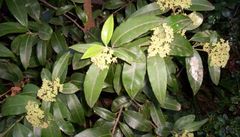Backhousia citriodora: Difference between revisions
Created page with '{{SPlantbox |familia=Myrtaceae |genus=Backhousia |species=citriodora |habit=tree |Max ht box=20 |Max ht metric=m |height_ref=Wikipedia |Temp Metric=°F |image=Backhousia citriodo…' |
No edit summary |
||
| Line 4: | Line 4: | ||
|species=citriodora | |species=citriodora | ||
|habit=tree | |habit=tree | ||
|Min ht box=10 | |||
|Min ht metric=ft | |||
|Max ht box=20 | |Max ht box=20 | ||
|Max ht metric=m | |Max ht metric=m | ||
|height_ref=Wikipedia | |height_ref=Wikipedia | ||
|origin=Australia | |||
|origin_ref=Flora - A Gardener's Encyclopedia ISBN 0881925381 | |||
|lifespan=perennial | |||
|life_ref=Flora - A Gardener's Encyclopedia ISBN 0881925381 | |||
|exposure=sun, part-sun | |||
|sun_ref=Flora - A Gardener's Encyclopedia ISBN 0881925381 | |||
|water=moist | |||
|water_ref=Flora - A Gardener's Encyclopedia | |||
|features=evergreen, flowers, fragrance | |||
|flower_season=early summer, mid summer, late summer | |||
|flower_ref=Flora - A Gardener's Encyclopedia ISBN 0881925381 | |||
|Temp Metric=°F | |Temp Metric=°F | ||
|min_zone=9 | |||
|usda_ref=Flora - A Gardener's Encyclopedia ISBN 0881925381 | |||
|max_zone=10.5 | |||
|image=Backhousia citriodora.jpg | |image=Backhousia citriodora.jpg | ||
|image_width=240 | |image_width=240 | ||
| Line 21: | Line 37: | ||
===Propagation=== | ===Propagation=== | ||
Cuttings or fresh seeds. | |||
===Pests and diseases=== | ===Pests and diseases=== | ||
Latest revision as of 14:22, 28 March 2011
| Backhousia citriodora subsp. var. | ||||||||||||||||||||||||||||||||||||||||||||||||||||||||
|---|---|---|---|---|---|---|---|---|---|---|---|---|---|---|---|---|---|---|---|---|---|---|---|---|---|---|---|---|---|---|---|---|---|---|---|---|---|---|---|---|---|---|---|---|---|---|---|---|---|---|---|---|---|---|---|---|

|
|
| ||||||||||||||||||||||||||||||||||||||||||||||||||||||
| ||||||||||||||||||||||||||||||||||||||||||||||||||||||||
Backhousia citriodora (common names lemon myrtle, lemon scented myrtle, lemon scented ironwood) is a flowering plant in the family Myrtaceae, genus Backhousia. It is endemic to subtropical rainforests of central and south-eastern Queensland, Australia, with a natural distribution from Mackay to Brisbane.[1] Other common names are sweet verbena tree, sweet verbena myrtle, lemon scented verbena, and lemon scented backhousia.
It can reach 20 m ft in height, but is often smaller. The leaves are evergreen, opposite, lanceolate, 5 - 12 cm long and 1.5 - 2.5 cm broad, glossy green, with an entire margin. The flowers are creamy-white, 5–7 mm diameter, produced in clusters at the ends of the branches from summer through to autumn, after petal fall the calyx is persistent.
Cultivation
Lemon myrtle is a cultivated ornamental plant. It can be grown from tropical to warm temperate climates, and may handle cooler districts provided it can be protected from frost when young.[1] In cultivation it rarely exceeds about 5 m ft and usually has a dense canopy. The principal attraction to gardeners is the lemon smell which perfumes both the leaves and flowers of the tree. Lemon myrtle is a hardy plant which tolerates all but the poorest drained soils.[1] It can be slow growing but responds well to slow release fertilisers.
Seedling lemon myrtle go through a shrubby, slow juvenile growth stage, before developing a dominant trunk. Lemon myrtle can also be propagated from cutting, but is slow to strike.[1] Growing cuttings from mature trees bypasses the shrubby juvenile stage. Cutting propagation is also used to provide a consistent product in commercial production.
Propagation
Cuttings or fresh seeds.
Pests and diseases
A significant fungal pathogen, myrtle rust (Uredo rangelii) was detected in lemon myrtle plantations in January 2011.[2][3] Myrtle rust severely damages new growth and threatens lemon myrtle production. Controls are being developed.
Varieties
Gallery
-
photo 1
-
photo 2
-
photo 3
References
External links
- w:Backhousia citriodora. Some of the material on this page may be from Wikipedia, under the Creative Commons license.
- Backhousia citriodora QR Code (Size 50, 100, 200, 500)
